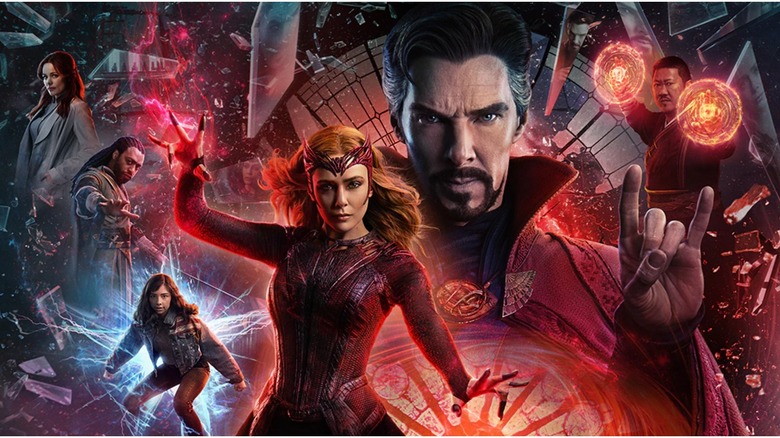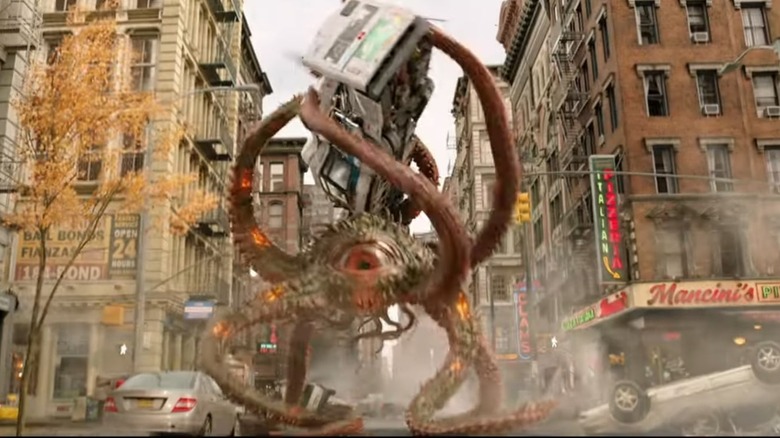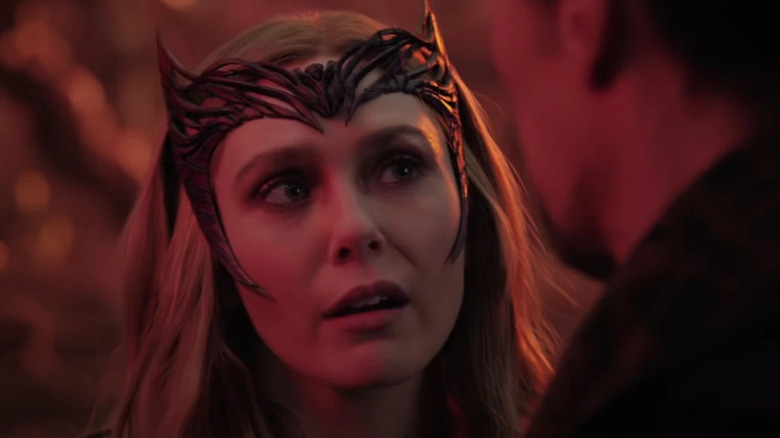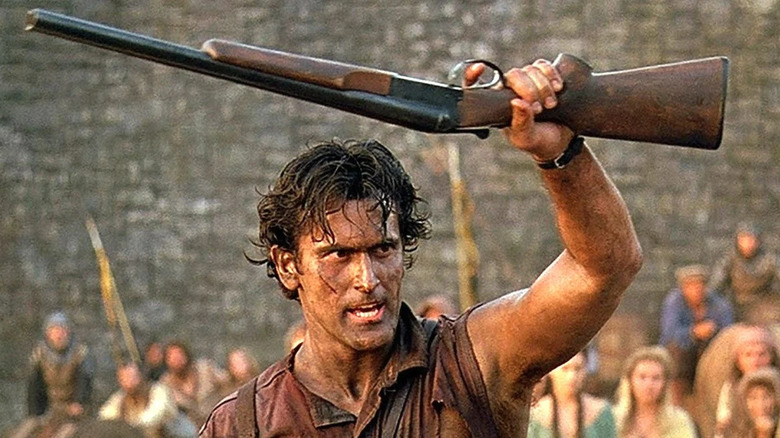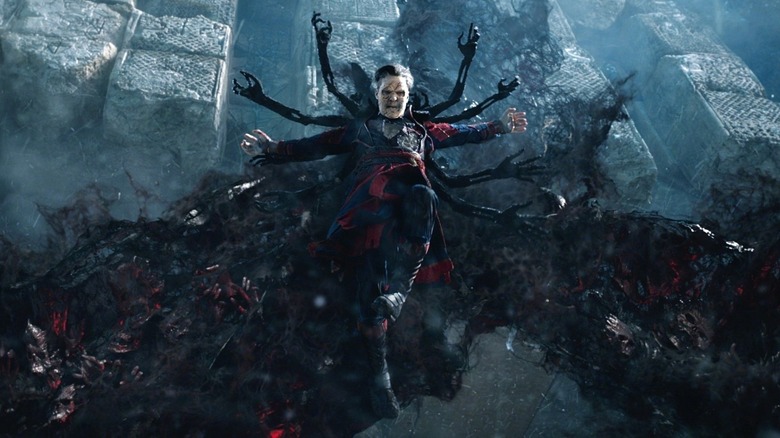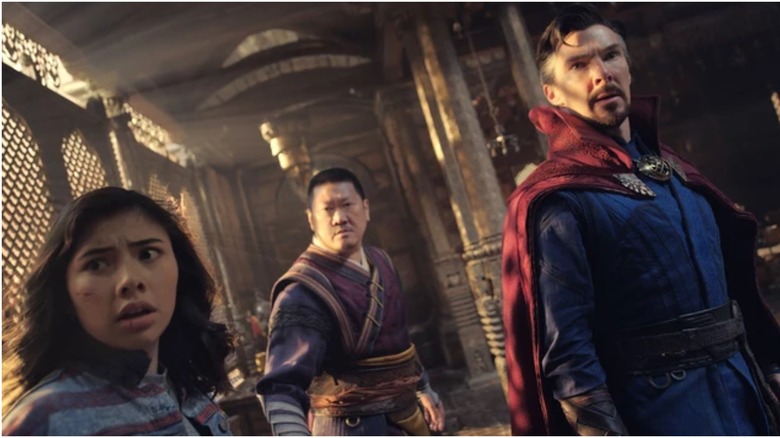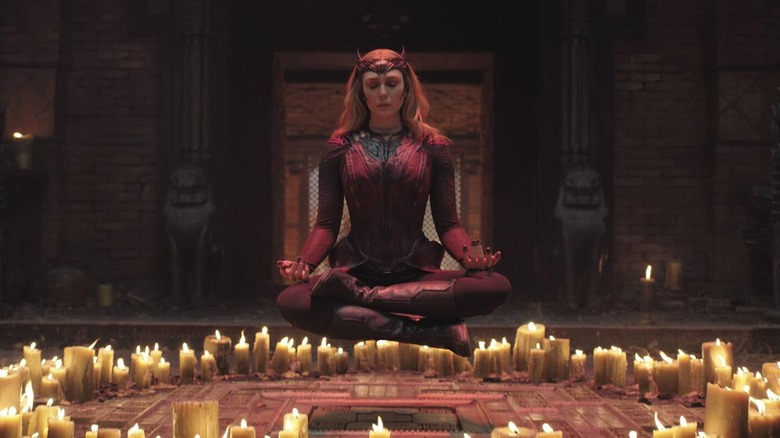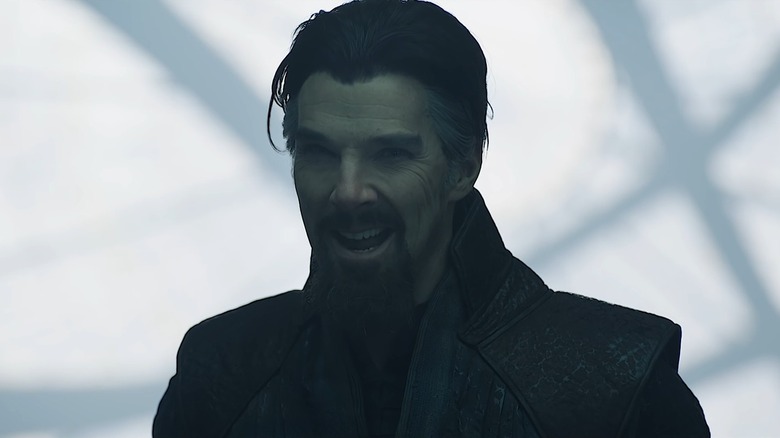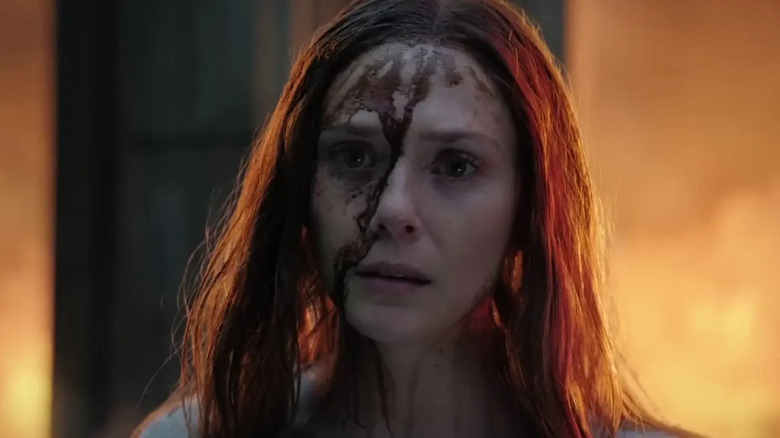The 8 Best Scenes In Doctor Strange In The Multiverse Of Madness, Ranked
Warning: abandon all hope (of seeing "Doctor Strange in the Multiverse of Madness" unspoiled) ye who enter here.
Even with its messy script, "Doctor Strange in the Multiverse of Madness" manages plenty of memorable moments. The goriest and most gothic Marvel movie yet, there's also an argument to be made that "Multiverse of Madness" is the best directed of its brethren. This is all thanks to Sam Raimi, who wields his ample experience directing horror and blockbusters alike to give this movie the same manic energy he brought to the "Evil Dead" and "Spider-Man" trilogies. Let's count down the eight best scenes that showcase just how much Raimi let loose — even within the confines of the Marvel Cinematic Universe.
8. Strange and Wong vs. Gargantos
The second set-piece of the film is, like many MCU action beats, set in the middle of downtown New York City. The villain is Gargantos, an enormous green-skinned demon with many-tentacled limbs and one eye; a fitting appearance since its one-track mind is set on capturing America Chavez (Xochtil Gomez). Sorcerers Supreme Doctor Strange (Benedict Cumberbatch) and Wong (Benedict Wong) aren't about to have that though.
The staging of the scene recalls Spider-Man and Doc Ock's first clash in Raimi's "Spider-Man 2;" the hero is fighting a tentacled villain holding a powerless hostage (there it was Peter's Aunt May, here it's America) who winds up sitting atop a skyscraper ledge. Gargantos meets a much nastier fate than Octavius though, being impaled through its eye.
Raimi is also sure to include shots showing the battle from civilians' POVs, emphasizing their panic throughout the sequence. Touches like these go a long way towards making the setting feel like New York itself and not just a green screen approximation.
7. Run
So much of superhero art is built on dynamic poses and group shots. This is just one way the MCU doesn't measure up to the beauty of its source material. The blocking in most Marvel movies can best be described as utilitarian. A brief but pivotal moment during Wanda's attack on Kamar-Taj is Raimi showing them how it's done.
When the temple's defenders combine their magic to create an impenetrable shield, Wanda singles out a weak-willed sorcerer. Manifesting from behind him, she whispers a simple piece of advice to him: "run." He obliges, and with a single link broken, the entire chain collapses.
The moment demonstrates how filmmaking basics are essential and how details add up. For the shot of Wanda emerging, Raimi pays close attention to the rule of thirds, positioning the sorcerer on the far right of the frame and leaving plenty of space open for Wanda to slither in beside him.
The credit can't be laid solely at Raimi's feet, though. Some must go to the movie's other MVP, Elizabeth Olsen. The actor manages just one syllable of dialogue memorable, sliding it off the tip of her tongue with the same relish as lines two dozen times as long.
6. Fourth-wall breaking post-credits scene
Another MCU trademark are post-credits scene, always a comedy beat or set-up for future movies. "Multiverse of Madness" doesn't break tradition, offering one of each. The first mid-credits scene falls into the set-up category and is nothing to write home about. Clea (Charlize Theron) appears and recruits Strange to help her with some business in the Dark Dimension.
The comedic post-credits scene, on the other hand, is one of the film's funniest moments. As almost always, Raimi found a place for his friend Bruce Campbell to cameo. Specifically, as Pizza Poppa, the vendor of a pizza ball stand on Earth-838. After annoying Strange and America, the former casts a spell on Pizza Poppa that makes him hit himself over and over. In the post-credits scene, we return to an exhausted Pizza Poppa just as the spell lifts. Looking directly into the camera with a cheeky grin, he declares, "It's over!"
5. Zombie Strange corrals the damned
I previously mentioned that there were times in "Multiverse of Madness" where Raimi was in "Evil Dead" mode. Many of those moments come in the film's third act. For one, Strange dream-walks into the corpse of his "Defender" self to rescue America from Wanda. With rotting skin and only half a jaw, it's miraculous that Marvel and Cumberbatch agreed to let Strange look outright grotesque onscreen. But it doesn't end there.
As Strange approaches Mount Wundagore, he's attacked by a swarm of black, skeletal phantoms. These damned souls taunt Strange like less vulgar Deadites; as they encircle his body, the scene resembles the ending of "Drag Me To Hell," where Christine (Alison Lohman) is pulled into the underworld by a crowd of demonic hands. Thankfully for Strange, this is a Marvel movie, not a horror film. Strange overpowers the damned souls and fashions them into a replacement for his cloak of levitation. This is the cherry on top of his undead appearance and provides the best melding of superhero tropes and horror imagery in the film.
4. Wanda escapes the mirror dimension
Returning to Wanda's attack on Kamar-Taj; after the shield fails, Strange tries to defeat the Scarlet Witch with misdirection instead. Strange traps Wanda in a mirror dimension maze. Her walking through it in a vain attempt to escape is one of the few parts of "Multiverse of Madness" which reuses the kaleidoscope imagery from the first "Doctor Strange."
After her attempt to blast her way out fails, Wanda looks into her reflection and reaches out, the glass turning to black water as her arm dives deeper. The shot recalls not only Raimi's own "Evil Dead II," but also John Carpenter's "Prince of Darkness," another film about a monster trapped between worlds with their only way out being through a mirror.
From there, unnamed sorcerers disappear into their reflections as Strange, Wong, and America are reframed with Dutch angles. In a Raimi movie, the camera tilting sideways is always a sign that something evil is brewing. After their attempt to block all reflections in the room fail, Wanda emerges from the mirror dimension contorting like a stop-motion character. The sound of her bones crackling and then repairing themselves is audible as she resumes her upright posture.
3. Wanda dreamwalks
Exposition is a necessary evil in a film like this, but the least you can do is make it visually interesting. Not all such scenes in "Multiverse of Madness" hit this bare minimum, but one that blows past it is Earth-838 Mordo explaining the concept of dream-walking. As Strange and America listen, the film cross-cuts back to a hovering, meditating Wanda, preparing to seize control of her variant on the other Earth.
This montage sequence is the best editing in the film. Raimi and his go-to editor Bob Murawski have been ones for utilitarian transitions, and the scene uses a mix of overlay inserts, fades, and close-ups of varying intensities to create a delirious swirl of character reactions. Raimi has used this type of montage before, from one showing the progress in the gunslinging competition in "The Quick and the Dead" to Peter designing his costume in "Spider-Man." If it ain't broke, don't fix it.
Once the preparations are set, Wanda possesses her 838 counterpart. Outside of the third act, this is the most "Evil Dead" like that "Multiverse of Madness gets. Raimi shoots the disembodied 616 Wanda stalking her other self from a constantly moving first-person POV, much like the view of the evil forces in the forest in "Evil Dead." Soon afterward, there's a jump scare when 838 Wanda leans into a window and sees the Scarlet Witch staring back. It'd be a stretch to call these moments scary, but they're undeniably shot and framed like horror scenes. The MCU generally abides by a house-style aesthetic, so stylistic touches like these that break the mold are most welcome.
2. Music note fight
The best part of the film involving Doctor Strange himself is when he confronts a Darkhold-corrupted variant of himself. The hero battling an evil version of themselves is more familiar territory for Raimi (sensing a pattern here?); "Sinister Strange" is part and parcel with Evil Ash from "Army of Darkness."
What makes the scene memorable is the weapons that Stranges Stephen and Sinister choose: music. As in, after their initial bout scatters some nearby sheet music, the two Stranges start magically lifting the notes off the page and hurl them at each other. As the musical magic flies through the air and makes contact, the appropriate note sounds off.
This moment is easily the most creative use of magic in "Multiverse of Madness," if not the whole MCU. Oftentimes, magic gets reduced to just different colored energy blasts and opening portals, even though it's theoretically able to do anything. This demands creativity equal to the level on display in this musical duel.
1. Wanda kills the Illuminati
"Multiverse of Madness" resists the urge to just be a cameo fest in the most brutal way possible. About halfway through the film, Strange is brought before the greatest heroes of Earth-838, the Illuminati: Mordo, Professor X (Patrick Stewart), Mister Fantastic (Reed Richards), Captain Carter (Hayley Atwell), Black Bolt (Anson Mount), and Captain Marvel (Lashana Lynch).
The introduction of the Illuminati grinds the film to a halt, but thankfully, it's just a brief respite. An already blood-doused Wanda marches into the Illuminati's headquarters and slaughters them, one by one. Before Black Bolt can use his super destructive voice, Wanda magically erases his mouth, Agent Smith to Neo style; when the Inhuman king attempts to speak, his head implodes. Seconds later, Wanda shreds Mister Fantastic (with the hardest line in the film: "Is [your wife] still alive? Good ... then there will be someone left to raise [your children]"). The women of the Illuminati put up a better fight, but it isn't long before Wanda bisects Carter with her own shield and crushes Captain Marvel beneath a statue. Xavier is the last to fall; he enters Wanda's mind to free her subjugated 838 self, but a demonic Scarlet Witch snaps his neck, killing him in the astral and physical planes alike.
The scene is the best action set-piece in "Multiverse of Madness," and by far the goriest. Part of the joy of horror movies, especially over-the-top ones like the type Raimi favors, is the creativity of the kills. Plus, the scene incorporates one last Raimi trademark: the zoom-in through a character's eye, in this case, Wanda's.
